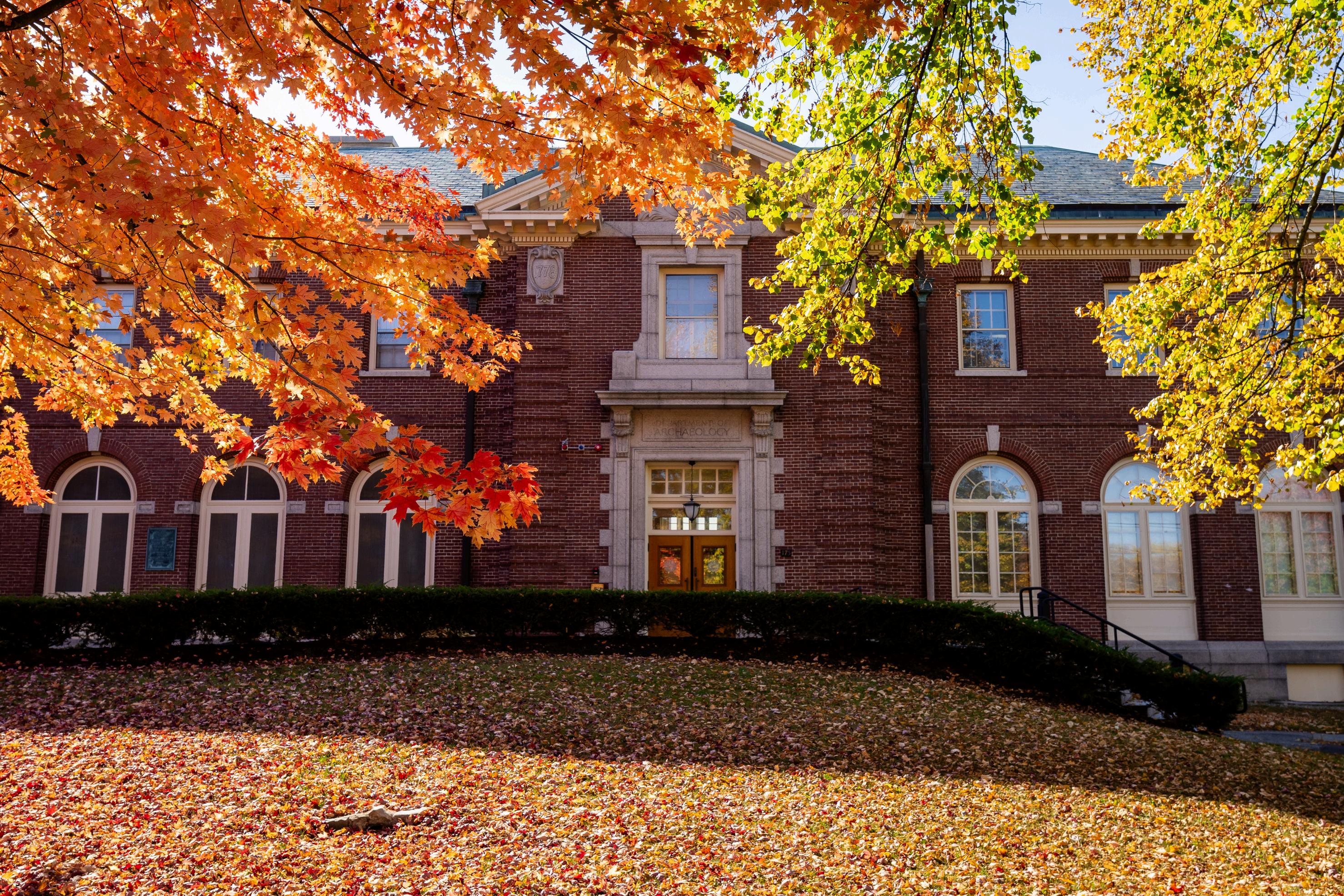PEABODY LESSON BOOKLET
FALL 2025



The Peabody supports learning in many academic departments, with established lesson plans that we continue to offer.





The Peabody supports learning in many academic departments, with established lesson plans that we continue to offer.

These lessons center Indigenous experiences and knowledges within broader areas of inquiry, integrating these perspectives as part of your course content to augment the discussions already in your classroom. They do not require that you are teaching a course specific to Indigenous topics or themes.
Reservation Relations:
Storytelling and Storywork
StorytellingisavitalpracticeforIndigenouspeoples,preserving andcommunicatinghistoryandshapingculturalexpressions andartforms.StoryworkisanIndigenousresearchframework thattakesseriouslytheprocessofmeaning-makingcontainedin thesharingofstories.
ThislessonpracticesstoryworkintellingthestoryofPeabody curatorWarrenK.Mooreheadandhis1909investigationofthe theftoflandsfromresidentsoftheWhiteEarthReservation. Associatedcollectionsconnectstudentstotheemotional resonanceoftherelationshipsbuiltbetweenMooreheadand thepeopleofWhiteEarth.Studentspracticetheirownstorywork throughacreativewritingexerciseinresponsetoaphotograph byvisualstorytellerLeeMarmon(LagunaPueblo).
MostrecentlyusedinENG300.
Themostwell-knowngroupoftheRedPowermovement,the AmericanIndianMovement(AIM)joinedinthesocialproteststhat shapedtheUnitedStatesofthe1960sand1970sandhelped inspiremovementsglobally.ThehistoryofAIMfitswithinany discussionofcivilrightswhileaddingtothemtheunique positionalityofNativeAmericansassovereignnations. Thislessonjoinssuchimportantconversationsbyaddressing someofthemostsignificantprotestsorganizedbyAIMduringthe heightofitsactions,connectingthemtothelongandongoing historyofNativeAmericanresistance,pastandpresent.
MostrecentlyusedinHSS300.
Seekingtounderstandwhatjusticeisrequiresustoconsiderhow justicecanbeaccomplished. Thislessoncreatesacontextforstudentstodiscussrestorative justiceanditsapproachtoredressthroughconsiderationofselect Indigenouscollections.Puttingtheseinconversationwith retributiveandrehabilitativejustice,studentsgainan understandingoftheprinciplesofdifferentformsofjustice throughfocusonthespatialityandmaterialityofjudicial processes.
MostrecentlyusedinPHR513.
Skills-based lessons demonstrate to students the factors that shape research processes, impacting both what we learn and how, and offer approaches for navigating these. They can be used to complement course skills grids, and are especially well suited for courses with interdisciplinary content.
The1990NativeAmericanGravesProtectionandRepatriation Act(NAGPRA)markedaturningpointforarchaeologists, museums,andNativepeoples.Thislawrequiresmuseumsto consultwithtribalnationsandrepatriateancestralremains, funeraryobjects,andothersacreditemspreviouslyallowedto beexcavatedandheldbymuseums,fundamentallychanging professionalbestpracticeforarchaeologistsandmuseumsalike. Thislessonintroducesstudentstothislawandtheparticipation ofPhillipsAcademyandthePeabodyInstituteinits implementation.Itadditionallysituatestheworkofthis legislationwithinthecontextofeffortstounderstandandheal thewoundsofcolonialism. MostrecentlyusedinHSS300,HSS320B,andPHR533.
Thislessondevelopsstudents’researchskillsbyhelpingthemto considerhowitisweknowwhatwethinkweknowaboutthepast, understandingbiasintheprimarysourcerecordandintroducing provenienceandprovenanceaskeyterms.Practicingsmallgroup workandusingcollectionsfromtheAncientMediterranean, studentsareaskedtointerpretcollectionsasimaginedfromthe perspectivesofmultiplelocationswithintheRomanEmpire.Along withpracticingcarefulobservationandcriticalthinking,thislesson helpsstudentstoexperiencethecrucialimpactofcontextonthe interpretiveprocess.
MostrecentlyusedinHSS100.
HowdocollectionsgettoplaceslikethePeabody?Whatdecides whichkindsofcollectionsgotowhichkindsofinstitutions?What happenstotheirdocumentation?Howdotheseroutesimpact whatandhowwecanlearnfromthem?Whydoesanyofthis matter?
Thislessonintroducesstudentstosomecommonmuseum histories,withdiscussionofthebiasestheyembedintheprimary sourcestheyseektopreserveandtheirimpactoncontemporary bestpracticeinthefield.
MostrecentlyusedinHSS563.

Collections-based learning is an incredible tool for teachers. Applying abstract ideas to something physically in front of them simultaneously focuses students’ minds while opening their imaginations, expanding the questions they ask and the connections they make.
Below is a small sampling of some of the collections available at the Peabody, that can be engaged to explore any number of themes and topics.
ThiscollectionofMayatextileswasamassedinGuatemalainthe 1970sforimportandsaleintheUSandconsistsofhundredsof examplesofwearableart.Madebywomenandwornbyeveryone, thisclothingisacomplexartisticexpressionthatcombines aestheticsandtechnicalproficiencywithculturalandpersonal identity.Thecollectionfurtherincludesexamplesofworksstillon theloom,demonstratingprocessalongsideofproduct,andslides ofstreetscenesfromtheareasinwhichthetextileswereacquired.
Itemscanbeengagedtodiscusstopicsinwomen’srights; intellectualpropertyandappropriation;formsoflanguageand communication;personalexpressionandinnovation;choicesand usesoftechnology;amongothers.
MostrecentlyusedinSPA501andHSS581.
ThesecollectionsfromtheSouthwesternUSareexpansive, ranginginmediaandrepresentingapproximately1,000yearsof history,uptoandincludingrecentitemscreatedby contemporaryartistsandcultureholders.TheSouthwest collectionsadditionallyoverlapwiththePeabody’sphotographic holdings,includingworksfromIndigenousandnon-Indigenous photographers.
Itemscanbeengagedtodiscusstopicsinculturalexchange, continuity,andsurvivance;representationandaudience;design andtechnique;interpretivemethods,collectionsbias,and knowledgetransmission;amongothers.
MostrecentlyusedinHSS200andENG300.
FormanyNativeAmericans,basketsarerepresentationsof community.Assuch,theybringthewholeoflifeintothe classroom,includingareasthatoftenarenotpreservedelsewhere inourhistoricalrecords,orareotherwiseoftenoverlooked.The Peabodycaresforatleast200basketsfromvariouspartsofthe UnitedStates.Regionalstrengthswithinthecollectionincludethe Northeast,providingopportunityforalocalfocus.
Itemscanbeengagedtodiscusstopicsingender;ecology; sequenceandgrowingpatterns;artistgenealogies;amongothers.
Soontobeusedbycleverfacultywhoknowagoodopportunity whentheyseeone.
For further ideas for connecting Indigenous content to subjects across the curriculum, see the faculty resources prepared by MLK Scholar Sam Clare (’25), available on the Peabody Space on PANet:
https://panet.andover.edu/spaces/18/peabody-institute-ofarchaeology/articles
Don’t forget to schedule a storage tour as an activity for your advising group, department, or visiting scholars!



